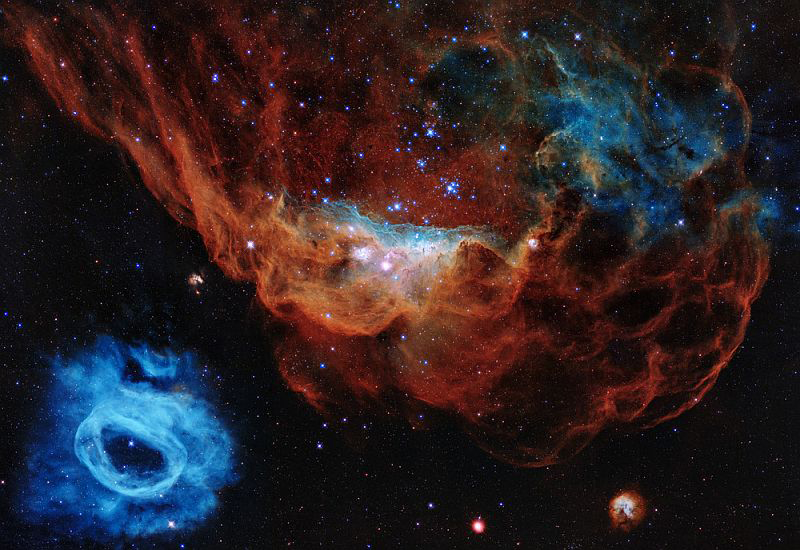Empyrean Reef
by Harley White
- Published: Monday, November 30 -0001 00:00

Ocean reefs are made by coral
builder types, in sundry frames,
crafted to resemble floral
forms though with aquatic aims.
These are ecosystems vital
called ‘rainforests of the sea’
as an honorary title
to denote their status key
in affording species varied
with a domicile marine
where those creatures long have tarried,
settled in the briny scene.
An image labeled ‘Cosmic Reef’
parallels that special place,
like sparkling undersea motif
shimmering in outer space.
The Hubble telescope each year
takes snapshot to celebrate
the genesis of its career
as celestial viewer great.
Named for the man who saw outside
our galaxy Milky Way,
Edwin Hubble knew he had spied
something beyond its array.
In nineteen ninety was its launch
the Discovery aboard,
deployed into Earth orbit staunch
to bestow the grand reward
of opening firmament’s door
to the heavens vast explore
as never envisioned before,
furnishing vistas galore.
Anniversary thirty brought,
midst the pictures aplenty,
this striking astro-portrait wrought
by Hubble cognoscenti.
A nebula red gigantic
in Large Magellanic Cloud
shown with smaller blue, is frantic
to birth sidereal crowd.
One hundred sixty-three thousand
light-years afar, the splendid
tapestry raises eyebrows and
wears colors richly blended,
with stars in big one more massive
by ten to twenty times Sun.
The lesser in no way passive
is made from huge star to stun,
two hundred thousand times brighter
than the lamp that lights our days
whose glories many a writer
has sung with poetic praise.
NGC twenty twenty plus
fourteen are part of a site
in Large Cloud, which is dwelling thus
as galaxy satellite
going round the Milky abode
where life for us was fated,
in our brief ylem episode
the cosmos has created…
Richard Feynman physicist famed
for discoveries disclosed,
albeit in science acclaimed,
a work in free verse composed.
‘I stand at the seashore, alone,
and think, there are rushing waves,’
said Feynman in a pensive tone
as consciousness birth he braves.
‘Mountains of molecules make up
the surf,’ to Feynman rephrase,
and then his ponderings take up
the theme of tidal ballets
‘pounding the shore, age after age,
tortured by energy’, till
novel DNA dance on stage
finds the design to fulfill
a formula for awareness,
curiousness to perplex,
of seeming marvelous rareness,
through ‘protein pattern complex’.
Feynman his reveries ending
‘stands in wonder at the sea,
wonders at wondering’s wending,
atom in universe’, he,
‘a universe of atoms new
out of the cradle’ in thought,
matter that sprang out of the blue.—
Did earthlings emerge for naught?
Sentient beings intricate are,
ever at crossroad of choice,
forged from the remnants of a star,
yet humans could lose their voice.
If knowledge of self, surroundings
led to senses unruly
in our evolution’s foundings,
have we consciousness truly?
~ Harley White
* * * * * * * * * *
Some sources of inspiration were the following…
A Universe of Atoms, An Atom in The Universe ~ Poem written by physicist Richard Feynman…
https://www.wondersofphysics.com/2019/05/poem-by-richard-feynman.html
Image and article, with video ~ Hubble Marks 30 Years in Space with Tapestry of Blazing Starbirth…
https://www.nasa.gov/feature/goddard/2020/hubble-marks-30-years-in-space-with-tapestry-of-blazing-starbirth/
Image and info ~ Hubble’s Cosmic Reef, at APOD…
https://apod.nasa.gov/apod/ap200425.html?fbclid
Explanation: These bright ridges of interstellar gas and dust are bathed in energetic starlight. With its sea of young stars, the massive star-forming region NGC 2014 has been dubbed the Cosmic Reef. Drifting just off shore, the smaller NGC 2020, is an expansive blue-hued structure erupting from a single central Wolf-Rayet star, 200,000 times brighter than the Sun. The cosmic frame spans some 600 light-years within the Large Magellanic Cloud 160,000 light-years away, a satellite galaxy of our Milky Way. A magnificent Hubble Space Telescope portrait, the image was released as part of a celebration to mark Hubble’s 30th year exploring the Universe from Earth orbit.
Image Credit: NASA, ESA, STScI







Comments